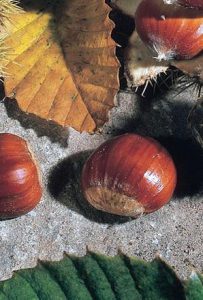How to Grow Sweet Chestnuts – A Guide to Growing Sweet Chestnuts
 Sweet chestnuts can be grown from seed, but the resulting tree could take as long as 20 years before producing fruit! Much better to buy a grafted bare-rooted tree from a reliable supplier, which should start fruiting much sooner.
Sweet chestnuts can be grown from seed, but the resulting tree could take as long as 20 years before producing fruit! Much better to buy a grafted bare-rooted tree from a reliable supplier, which should start fruiting much sooner.
Sweet chestnuts have good drought resistance once established.
Growing Sweet Chestnuts
- Bare rooted trees should be planted late autumn–early spring.
- Sweet chestnuts grow best in full sun, in a well-drained fertile, deep soil. The tree will not fruit in shade.
- Always plant your fruit tree so that the grafting union is above the level of the soil.
- Dig a hole large enough to comfortably accommodate the depth and size of the roots and water in well after planting.
- Remove any vegetation around the base of the tree and mulch well, to help keep in the moisture and discourage weeds, etc, growing and competing with the young tree.
- Sweet chestnuts flower June–July, when long catkins (both male and female) appear. The female flowers grow into the spiny green fruit containing one–three edible nuts.
Harvesting Sweet Chestnuts
- Harvest in October. The nuts are ripe when they drop from the trees as the chestnut burrs (the outer spiny skin) burst, but some nuts will need removing from their skin.
- Wearing strong gloves, pull open the burrs and remove the chestuts.
Pests and Problems with Sweet Chestnuts
- Squirrels may strip the bark from the trees as well as eating the nuts.
- Sweet chestnuts have been severly depleted by a fungal disease in recent years. Purchase your tree from a reputable supplier.
Varieties of Sweet Chestnut
- Be sure to buy a sweet (edible) chestnut, rather than a horse chestnut, from a reputable supplier.
- Bear in mind that not all varieties are self-fertile and that most varieties will eventually mature into a very large tree.
- The variety Regal is self-fertile, grows to around 5 m (15 feet) in height after 10 years and produces nuts after two–three years.
- Marigoule is another self-fertile variety and will start to fruit within 2–4 years.
Eating
- Chestnuts can be eaten raw but are usually cooked, or roasted before eating. They can also be pickled.
- The cooked nuts can be ground to make flour and be used as a thickener. They are also used in confectionary and puddings for their sweetness. The nuts are delicious roasted.



